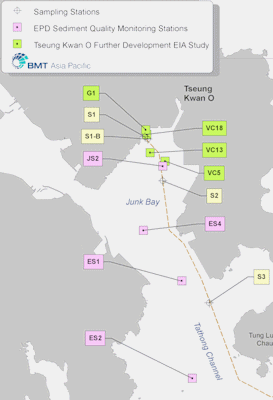Waste Assessment
The key potential waste impact from the project is during the construction phase which
may involve the management of dredged sediments from within Junk Bay in relation to
the laying of a portion of the transmission cable. Up to 135,000 m3 of marine
sediment would be dredged.
In order to characterize the marine sediment in the Study Area, a sampling and
analysis programme was conducted in accordance with ETWB 34/2002. The first task
involved a Tier I desktop sediment quality review of existing sediment quality data for
the potential dredging zone (G1, VC16, VC13, VC5, JS2, ES4, ES1, ES2).
Following the desktop review, a Tier II sampling and chemical screening programme
was devised and agreed with EPD. This involved sediment collection at three
nearshore stations in Junk Bay / Tathong Channel (S1, S2, S3) in January 2007.
Sub-samples ‘S1-1’ and ‘S2-2’ are categorized as Type 2 sediment as levels of zinc
exceed the UCEL, although in accordance with Clause 2(d) of ETWB 34/2002 Appendix
B there is no requirement for Tier III biological screening as contamination levels are
<10 times the LCEL.
In accordance with Appendix C of ETWB 34/2002, the upper 0.9m of sediment at
stations S1 and S2 will thus require Type 2 confined marine disposal. As per the
Dumping at Sea Ordinance (Cap. 466), ‘Category H’ sediment must be carefully
dredged and transported, and effectively isolated from the environment upon final
disposal.
It is anticipated that surface sediment from the potential marine dredging in the vicinity
of stations S1 and S2 would be disposed of at East Sha Chau, being the designated
site for confined marine disposal. The disposal method shall be subject to the
agreement of the Marine Fill Committee (MFC) of CEDD in due course.
As the Tier II chemical screening results indicate that only surface sediment is
contaminated, it is proposed that surface grab samples be collected in a focused
investigation area in advance of any dredging works in order to comply with the specific
requirements of the Dumping at Sea Ordinance. This approach will enable the volume
of contaminated sediment requiring confined marine disposal to be accurately
quantified.
The fate and magnitude of dredged sediment impacts is reviewed within the Water
Quality Assessment.
.
The key potential waste impact from the project is during the construction phase which
may involve the management of dredged sediments from within Junk Bay in relation to
the laying of a portion of the transmission cable. Up to 135,000 m3 of marine
sediment would be dredged.
In order to characterize the marine sediment in the Study Area, a sampling and
analysis programme was conducted in accordance with ETWB 34/2002. The first task
involved a Tier I desktop sediment quality review of existing sediment quality data for
the potential dredging zone (G1, VC16, VC13, VC5, JS2, ES4, ES1, ES2).
Following the desktop review, a Tier II sampling and chemical screening programme
was devised and agreed with EPD. This involved sediment collection at three
nearshore stations in Junk Bay / Tathong Channel (S1, S2, S3) in January 2007.
Sub-samples ‘S1-1’ and ‘S2-2’ are categorized as Type 2 sediment as levels of zinc
exceed the UCEL, although in accordance with Clause 2(d) of ETWB 34/2002 Appendix
B there is no requirement for Tier III biological screening as contamination levels are
<10 times the LCEL.
In accordance with Appendix C of ETWB 34/2002, the upper 0.9m of sediment at
stations S1 and S2 will thus require Type 2 confined marine disposal. As per the
Dumping at Sea Ordinance (Cap. 466), ‘Category H’ sediment must be carefully
dredged and transported, and effectively isolated from the environment upon final
disposal.
It is anticipated that surface sediment from the potential marine dredging in the vicinity
of stations S1 and S2 would be disposed of at East Sha Chau, being the designated
site for confined marine disposal. The disposal method shall be subject to the
agreement of the Marine Fill Committee (MFC) of CEDD in due course.
As the Tier II chemical screening results indicate that only surface sediment is
contaminated, it is proposed that surface grab samples be collected in a focused
investigation area in advance of any dredging works in order to comply with the specific
requirements of the Dumping at Sea Ordinance. This approach will enable the volume
of contaminated sediment requiring confined marine disposal to be accurately
quantified.
The fate and magnitude of dredged sediment impacts is reviewed within the Water
Quality Assessment.
.


Please click on the sampling stations to see the results
